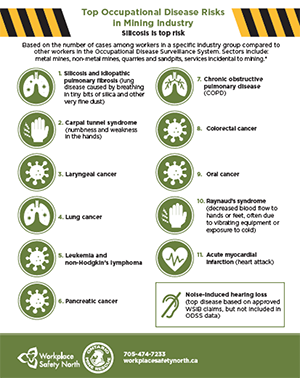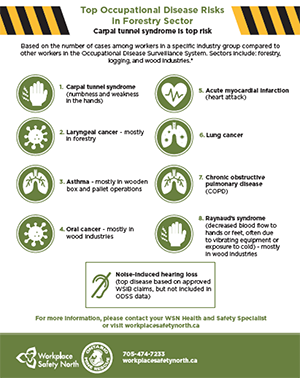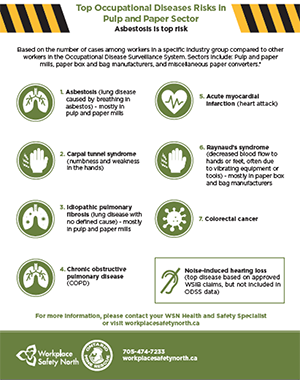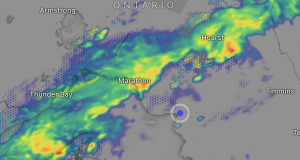Workplace Safety North (WSN) in partnership with the Occupational Cancer Research Centre (OCRC) has launched three new posters showing the top occupational disease risks in the forestry, mining, and pulp and paper sectors.
Occupational diseases are health problems that can affect workers because of the type of work they do. An occupational illness happens when someone gets sick from being exposed to things like chemicals or germs at work, which can affect the body’s normal functions and make the worker less healthy.
There were 40,185 allowed occupational disease claims in 2022, according to the Ontario Workplace Safety and Insurance Board (WSIB). Occupational illness claims totalled $82.5 million in 2022 according to the WSIB. However, claims data may not show the complete picture. WSN and OCRC explored the top occupational disease risks in three different industries: mining, forestry, and pulp and paper.
“These risks are based on data from the Occupational Disease Surveillance System, which monitors disease outcomes among over two million workers in Ontario,” says Dr. Paul Demers, OCRC Director. “Each sector’s rankings are based on an increased risk of disease compared to other workers in the disease surveillance system.
Health data come from many sources, including the Ontario Cancer Registry, OHIP, and hospital records from 1964 to 2020. This information is vital for both workers and employers to ensure a safe workplace.
“Not all diseases have been studied in Ontario’s occupational disease surveillance system,” notes Demers. “For example, based on Workplace Safety and Insurance Board (WSIB) approved claims, noise-induced hearing loss is a leading occupational disease in the forestry, mining, and pulp and paper industries, but has not been studied in our surveillance system. Top-ranked diseases may change over time as the ODSS data and prevention controls continue to evolve.”
Mining sector
 The mining industry plays a crucial role in extracting valuable resources from the earth, but it also exposes workers to certain health risks. Here are the top occupational disease risks in this industry, including metal mines, non-metal mines, quarries, sandpits, and services related to mining:
The mining industry plays a crucial role in extracting valuable resources from the earth, but it also exposes workers to certain health risks. Here are the top occupational disease risks in this industry, including metal mines, non-metal mines, quarries, sandpits, and services related to mining:
- Silicosis and Idiopathic Pulmonary Fibrosis: Lung disease happens when workers breathe in hazards like dusts, gases, and fumes. Silicosis can develop over time from inhaling tiny bits of silica dust, found in sand, rocks and soils.
- Carpal Tunnel Syndrome: Miners may experience numbness and weakness in their hands due to repetitive tasks and heavy machinery operation.
- Laryngeal Cancer
- Lung Cancer: Miners may be exposed to many hazards that can cause lung cancer, including diesel engine exhaust, silica, nickel, radon, and arsenic.
- Leukemia and non-Hodgkin’s Lymphoma
- Pancreatic Cancer
- Chronic Obstructive Pulmonary Disease (COPD): Long-term exposure to dust and pollutants in mining can lead to COPD.
- Colorectal Cancer
- Oral Cancer
- Raynaud’s Syndrome: Reduced blood flow to hands or feet, often caused by vibrating equipment and exposure to cold temperatures, can affect miners.
- Acute Myocardial Infarction: Workers in mining are at higher risk of heart attacks.
Noise-induced hearing loss is also a top disease based on approved WSIB claims.
Forestry sector
 In the forestry sector, workers face unique health risks related to outdoor work and specific industry processes. Here are the top occupational disease risks in the forestry, logging, and wood industries:
In the forestry sector, workers face unique health risks related to outdoor work and specific industry processes. Here are the top occupational disease risks in the forestry, logging, and wood industries:
- Carpal Tunnel Syndrome: Workers in forestry may experience hand numbness and weakness due to repetitive tasks.
- Laryngeal Cancer: Forestry workers are at higher risk for developing this cancer.
- Asthma: Workers in wooden box and pallet operations may develop asthma due to exposure to wood dust and other allergens.
- Oral Cancer
5. Acute Myocardial Infarction: Workers in this sector have a higher risk of heart attacks. - Lung Cancer: Exposure to pollutants including diesel engine exhaust from trucks and heavy equipment can contribute to lung cancer.
- COPD: Exposure to wood dust and other pollutants can contribute to breathing difficulties.
- Raynaud’s Syndrome: Reduced blood flow to hands or feet, often caused by vibrating equipment and exposure to cold temperature, can affect workers in wood industries.
Noise-induced hearing loss is also a top disease based on approved WSIB claims.
Pulp and paper sector
 In the pulp and paper sector, specific risks are associated with the materials and processes involved. Here are the top occupational disease risks for pulp and paper mills, paper box and bag manufacturers, and miscellaneous paper converters:
In the pulp and paper sector, specific risks are associated with the materials and processes involved. Here are the top occupational disease risks for pulp and paper mills, paper box and bag manufacturers, and miscellaneous paper converters:
- Asbestosis: This lung disease is caused by inhaling asbestos fibers, which may be present in pulp and paper mills due to historic use of asbestos.
- Carpal Tunnel Syndrome: Pulp and paper workers may experience carpal tunnel syndrome due to repetitive tasks.
- Idiopathic Pulmonary Fibrosis: This lung disease may affect workers in pulp and paper mills due to breathing in dusts and fibres.
- Chronic Obstructive Pulmonary Disease (COPD): Exposure to various dusts, fibres, vapours and fumes can increase the risk of COPD.
- Acute Myocardial Infarction: Workers in the pulp and paper sector are at higher risk of heart attacks.
- Raynaud’s Syndrome: Workers in paper box and bag manufacturing may experience reduced blood flow to hands or feet due to vibrating equipment and exposure to cold temperatures.
- 7. Colorectal Cancer
Noise-induced hearing loss is also a top disease based on approved WSIB claims.
Protecting Workers’ Health
It’s crucial to protect workers in these industries from occupational disease risks. Employers, managers, supervisors, and workers all share responsibility for occupational health and safety through the internal responsibility system. This system ensures everyone is aware of risks, follows safety procedures, and promotes a safer workplace.
Certified members of a joint health and safety committee (JHSC) and health and safety representatives (HSR) are important for finding and lessening dangers. To become certified for JHSC, they need training in three parts: general part one, sector-specific part two, and a refresher course every three years.
“Understanding and addressing occupational disease risks is crucial in safeguarding the health of workers in the mining, forestry, and paper and converting industries,” says Demers. “By implementing health and safety measures, conducting regular training, and promoting a culture of awareness, we can create safer workplaces for all employees.”
In October, the government of Ontario announced the creation of Canada’s first-ever Occupational Exposure Registry, an exposure data system to track harmful exposure levels, help diagnose workplace diseases faster, improve worker compensation, and reduce costs to the healthcare system. The Occupational Cancer Research Centre is working with the Ontario Ministry of Labour, Immigration, Training and Skills Development to establish this new exposure data system for Ontario.
- SSM RotaryFest Take Your Pick Draw is back - July 4, 2025
- Thank You – M.H.S. Graduation 2025 - July 2, 2025
- Men’s NIght Golf – June 26 - July 1, 2025
 Wawa-news.com You can't hear the 'big picture'!
Wawa-news.com You can't hear the 'big picture'!
